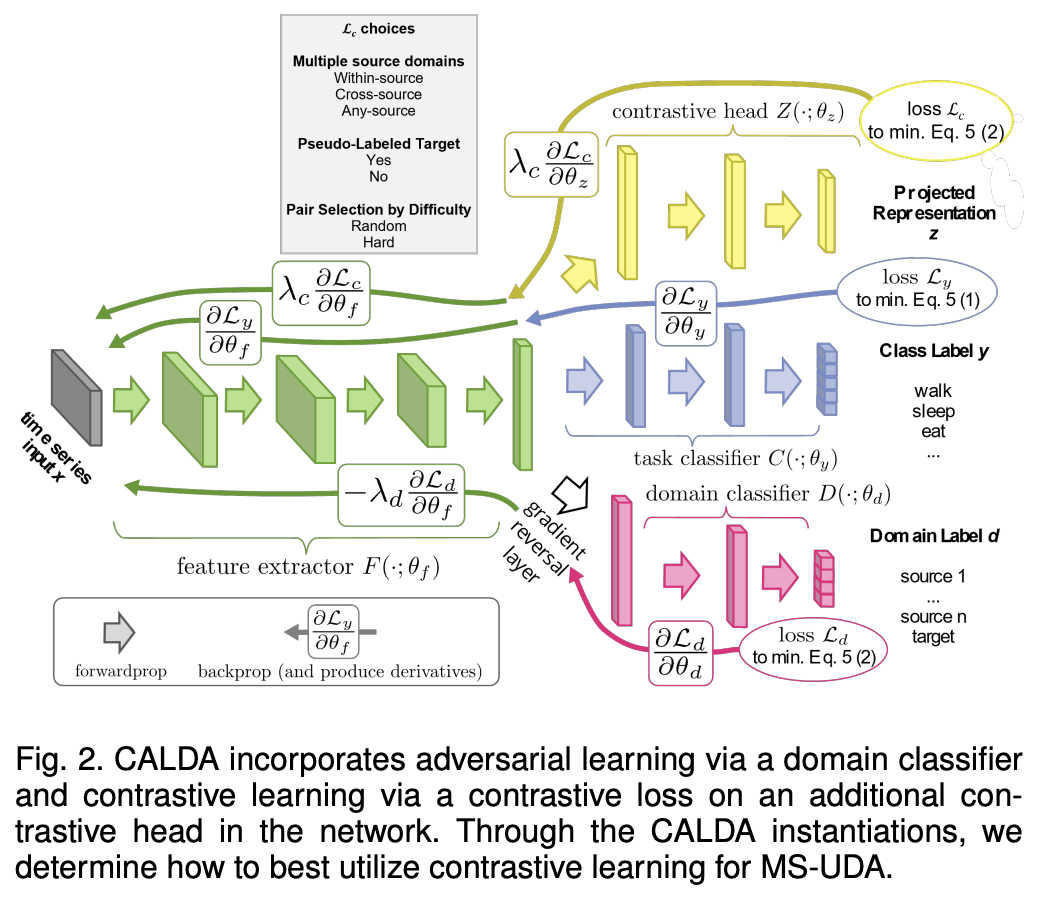Score-based Generative Modeling by Diffusion Process
1. Intro to Generative Models
Examples of Generative Model:
-
(1) Autoencoder (AE) ( + VAE )
-
(2) GAN
- (3) Normalizing Flows
- (4) SCORE-BASED GENERATIVE MODELS

2. Limitations of Generative Models
a) Categories of Generative Models
[1] Likelihood-based : Autoencoder (AE) ( + VAE ), Normalizing Flows
[2] GAN-based : GAN
b) Limitations
[1] Likelihood-based
- need specific architecture ( less flexible )
- ex) Autoregressive model, Flow model
- VAE: Surrogate loss ( ex. ELBO )
[2] GAN-based: unstable training
3. Generative Modeling by Estimating Gradients of the Data Distribution
(1) Score
Score
= (1) Gradient of (2) Log likelihood of Data
= \(\nabla_{\mathbf{x}} \log p(\mathbf{x})\).
주의할 점:
- parameter에 대한 score가 아니다 : \(-\nabla_\theta \log (\mathcal{L}(\theta))\) ……… (X)
- data에 대한 score 이다! : \(\nabla_{\mathbf{x}} \log p_{\text {data }}(\mathbf{x})\) ……….(O)
(2) Score Matching
전체 data에 대한 score를 계산은 불가능!
주어진 data에 대한 score를 계산하고, 전체 data에 대해 추정해야
\(\rightarrow\) need Score Estimator
( = 임의의 data에 대해 score를 추정하는 모델 )
Score Estimator, \(\mathbf{s}_\theta(x)\)
-
score estimator = score을 추정하는 모델
-
score matching = score estimator를 학습하는 방법
-
score matching의 objective function:
-
\(\mathcal{L}_\theta=\mathbb{E}_{p_{\text {data }}}\left\|\mathbf{s}_\theta(\mathbf{x})-\nabla_{\mathbf{x}} \log p_{\text {data }}(\mathbf{x})\right\|_2^2\).
( = (1) 실제 score & (2) 추정 score 간의 MSE )
-
Question)
\(p_{\text {data }}(\mathbf{x})\) 를 모르는데, (1) 실제 score는 어떻게 알지?
Answer)
위의 Loss function을, \(p_{\mathrm{data}}(\mathbf{x})\)에 의존하지 않도록 수식 유도 가능!
- (before) \(\mathcal{L}_\theta=\mathbb{E}_{p_{\text {data }}}\left\|\mathbf{s}_\theta(\mathbf{x})-\nabla_{\mathbf{x}} \log p_{\text {data }}(\mathbf{x})\right\|_2^2\)
- (after) \(\mathcal{L}_\theta=\mathbb{E}_{p_{\text {data }}(\mathbf{x})}\left[\operatorname{tr}\left(\nabla_{\mathbf{x}} \mathbf{s}_\theta(\mathbf{x})\right)+\frac{1}{2}\left\|\mathbf{s}_\theta(\mathbf{x})\right\|_2^2\right]\)
Problem?
문제점: \(\nabla_{\mathbf{x}} \mathbf{s}_\theta(\mathbf{x})\)에 대한 계산이 high-dim 상황에서 쉽지 않다!
해결책: DENOISING score matching
(3) Denoising Score Matching
(a) 아이디어: \(\operatorname{tr}\left(\nabla_{\mathbf{x}} \mathbf{s}_\theta(\mathbf{x})\right)\)에 대한 계산을 피하자!
(b) 핵심:
- 원본 data에 대한 score를 계산 (X)
- perturbed data에 대해 score 계산 (O)
(c) 방법:
- 미리 정의된 noise 분포 \(q_\sigma(\tilde{\mathbf{x}} \mid \mathbf{x})\) 를 이용
- perturbed data distn:
- \(q_\sigma(\tilde{\mathbf{x}}) \triangleq \int q_\sigma(\tilde{\mathbf{x}} \mid \mathbf{x}) p_{d a t a}(\mathbf{x}) \mathrm{d} \mathbf{x}\).
Loss function:
- (before) \(\mathcal{L}_\theta=\mathbb{E}_{p_{\text {data }}(\mathbf{x})}\left[\operatorname{tr}\left(\nabla_{\mathbf{x}} \mathbf{s}_\theta(\mathbf{x})\right)+\frac{1}{2}\left\|\mathbf{s}_\theta(\mathbf{x})\right\|_2^2\right]\)
- (after) \(\mathcal{L}_\theta=\mathbb{E}_{q_\sigma(\tilde{\mathbf{x}} \mid \mathbf{x}) p_{\text {data }}}\left[\left\|\mathbf{s}_\theta(\tilde{\mathbf{x}})-\nabla_{\tilde{\mathbf{x}}} \log q_\sigma(\tilde{\mathbf{x}} \mid \mathbf{x})\right\|_2^2\right]\)
한 줄 요약 : 원본 data distn 대신 perturbed data distn 사용하자!!
( perturbed data distn에 대한 density는 직접 계산 가능하므로! )
(4) Sampling with Langevin Dynamics
Training & Inference ( = Generating )
- Training : by Score Matching
- Inference : by Sampling
최적 parameter 찾기 ( = SGD )
- \(\theta_t=\theta_{t-1}-\eta \nabla_\theta \mathcal{L}(x ; \theta)\).
최적 data 찾기 ( = Sampling with Langevin Dynamics )
- \(\tilde{\mathbf{x}}_t=\tilde{\mathbf{x}}_{t-1}+\frac{\epsilon}{2} \nabla_{\mathbf{x}} \log p\left(\tilde{\mathbf{x}}_{t-1}\right)+\sqrt{\epsilon} \mathbf{z}_t, \quad \text { where } \mathbf{z}_t \sim \mathcal{N}(0, I)\).
- 앞서 학습한 score estimator를 사용해서 \(\nabla_{\mathbf{x}} \log p\left(\tilde{\mathbf{x}}_{t-1}\right)\)를 구함.
- \(\mathbf{z}_t\) : add RANDOMNESS
(5) Denoising Score Matching with Langevin Dynamics (SMLD)
앞선 두 가지를 합친 것을 SMLD라고 한다!
- (3) Denoising Score Matching ( = Training )
- (4) Sampling with Langevin Dynamics ( = Inference )
Noise Conditional Score Network
-
based on SMLD
-
data를 다양한 noise로 변환
& 변환된 data의 score를 추정!
-
score network vs. NOISE CONDITIONAL score network
- score network
- \(\mathbf{s}_\theta(\mathbf{x}) \approx \nabla_{\mathbf{x}} \log q(\mathbf{x})\).
- NOISE CONDITIONAL score network
- \(\mathbf{s}_\theta(\mathbf{x}, \sigma) \approx \nabla_{\mathbf{x}} \log q_\sigma(\mathbf{x})\).
- score network
4. Denoising Diffusion Probabilistic Modeling (DDPM)
SMLD ( Noise Conditional Score Network )
- step 1) data distn을 noise distn으로 변환
- step 2) noise distn으로부터 data 복원
DDPM : SMLD + Discrete Markov Chain
- 데이터의 noise add / remove 과정이 Discrete Markov Chain으로 표현된다.

(1) Forward Process ( = ADD nosie )
ONE-step
- \(p\left(\mathbf{x}_i \mid \mathbf{x}_{i-1}\right)=\mathcal{N}\left(\mathbf{x}_i ; \sqrt{1-\beta_i} \mathbf{x}_{x-i}, \beta_i \mathbf{I}\right)\).
- \(\beta\) : 0.0001 to 0.02
MULTI-step
- \(p_{\alpha_i}\left(\mathbf{x}_i \mid \mathbf{x}_0\right)=\mathcal{N}\left(\mathbf{x}_i ; \sqrt{\alpha_i} \mathbf{x}_0,\left(1-\alpha_i\right) \mathbf{I}\right), \quad \text { where } \alpha_i \triangleq \prod_{j=1}^i\left(1-\beta_j\right)\).
(2) Backward Process ( = REMOVE noise )
( forward: Gaussian \(\rightarrow\) backward: Gaussian )
ONE-step
- \(p_\theta\left(\mathbf{x}_{i-1} \mid \mathbf{x}_i\right)=\mathcal{N}\left(\mathbf{x}_{i-1} ; \frac{1}{\sqrt{1-\beta_i}}\left(\mathbf{x}_i+\beta_i \mathbf{s}_\theta\left(\mathbf{x}_i, i\right)\right), \beta_i, \mathbf{I}\right)\),
아래는 같은 표현!
- Sampling 한다
-
새로운 데이터를 생성한다
- Noise에서 시작해서 Backward Process를 여러 번 반복한다
- \(\mathbf{x}_{i-1}=\frac{1}{\sqrt{1-\beta_i}}\left(\mathbf{x}_i+\beta_i \mathbf{s}_{\theta^*}\left(\mathbf{x}_i, i\right)\right)+\sqrt{\beta_i} \mathbf{z}_i, \quad i=N, N-1, \ldots, 1\).
Ancestral Sampling
= 미리 정의한 conditional distn로 구성된 \(\prod_{i=1}^N p_\theta\left(\mathbf{x}_{i-1} \mid \mathbf{x}_i\right)\)로 데이터를 샘플링
DDPM & SGLD
= Score-based Generative Model
( \(\because\) 둘 다 data의 score를 간접적으로 추정! )
5. Score-based Generative Modeling through SDEs
DDPM & SGLD의 핵심
- data를 (여러 scale의) noise로 변환
- noise로부터 data를 복원
Noise의 scale = forward step의 횟수에 따라 결정!
- step \(\uparrow\) : noise \(\uparrow\)
- step \(\downarrow\) : noise \(\downarrow\)
Question) What if noise scale이 무한히 정밀??
\(\rightarrow\) Stochastic Differential Equations (SDE) 관점
- Noise를 time variable로 취급!
- (1) SDE : data 분포에 noise를 조금씩 더함
- (2) Reverse-time SDE : noise 분포에서 noise를 조금씩 제거함
(1) SDE
DE (Differential Equation, 미분방정식)
- \(f\) 를 모를 때, \(\nabla f\) 와 \(f(a)\) 를 사용해서 \(f\)를 추정!
SDE (Stochastic Differential Equation, 확률 미분방정식)
- DE + Stochastic Process
(2) Perturbing Data with SDEs
Notation
-
time variable: \(t \in[0, T]\)
- 초기값 ( = data 분포 ) : \(\mathbf{x}(0) \sim p_0\)
-
변환된 데이터 ( = noise 분포 ) : \(\mathbf{x}(T) \sim p_T\)
-
time variable에 대한 데이터 : \(\left\{\mathbf{x}(t)_{t=0}^T\right\}\)
( 즉, time variable \(t\)에 따라 data가 update된다! = Diffusion Process )
- data가 변화하는 정도 = \(\mathrm{d} \mathbf{x}\)
Diffusion Process
\(\mathrm{d} \mathbf{x}=\mathbf{f}(\mathbf{x}, t) d t+g(t) \mathrm{d} \mathbf{w}\).
- \(f(\cdot, t): \mathbb{R}^d \rightarrow \mathbb{R}^d\) : \(x(t)\) 의 drift coefficient
- \(\mathbf{x}\) 에 따른 함수값
- \(g(\cdot): \mathbb{R} \rightarrow \mathbb{R}\) : diffusion coefficient
- 해당 함수값에 얼마큼 noise를 부여할 지
- \(\mathbf{w}\) : Standard Winer Process ( for randomness )
(3) Generating Samples by Reversing the SDE
https://blog.si-analytics.ai/49
